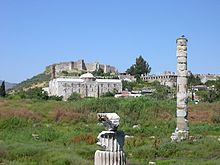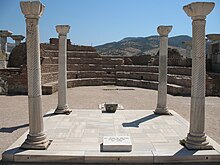Ephesus

Ephesus (/ˈɛfəsəs/;[1] Greek: Ἔφεσος Ephesos; Turkish: Efes; ultimately from Hittite Apasa) was an ancient Greek city[2][3] on the coast of Ionia, three kilometres southwest of present-day Selçuk in İzmir Province, Turkey. It was built in the 10th century BC on the site of the former Arzawan capital[4][5] by Attic and Ionian Greek colonists. During the Classical Greek era it was one of the twelve cities of the Ionian League. The city flourished after it came under the control of the Roman Republic in 129 BC.
The city was famed for the nearby Temple of Artemis (completed around 550 BC), one of the Seven Wonders of the Ancient World.[6] Among many other monumental buildings are the Library of Celsus, and a theatre capable of holding 25,000 spectators.[7]
Ephesus was one of the seven churches of Asia that are cited in the Book of Revelation.[8] The Gospel of John may have been written here.[9] The city was the site of several 5th century Christian Councils (see Council of Ephesus).
The city was destroyed by the Goths in 263, and although rebuilt, the city's importance as a commercial centre declined as the harbour was slowly silted up by the Küçükmenderes River. It was partially destroyed by an earthquake in 614 AD.
The ruins of Ephesus are a favourite international and local tourist attraction, partly owing to their easy access from Adnan Menderes Airport or from the cruise ship port of Kuşadası, some 30 km to the South.

Site of the Temple of Artemis in the town of Selçuk, near Ephesus.
Ephesus was founded as an Attic-Ionian colony in the 10th century BC on the Ayasuluk Hill, three kilometers (1.9 miles) from the centre of ancient Ephesus (as attested by excavations at the Seljuk castle during the 1990s). The mythical founder of the city was a prince of Athens named Androklos, who had to leave his country after the death of his father, King Kadros. According to the legend, he founded Ephesus on the place where the oracle of Delphi became reality ("A fish and a boar will show you the way"). Androklos drove away most of the native Carian and Lelegian inhabitants of the city and united his people with the remainder. He was a successful warrior, and as a king he was able to join the twelve cities of Ionia together into the Ionian League. During his reign the city began to prosper. He died in a battle against the Carians when he came to the aid of Priene, another city of the Ionian League.[17] Androklos and his dog are depicted on the Hadrian temple frieze, dating from the 2nd century. Later, Greek historians such as Pausanias, Strabo and Herodotos and the poet Kallinos reassigned the city's mythological foundation to Ephos, queen of the Amazons.
The Greek goddess Artemis and the great Anatolian goddess Kybele were identified together as Artemis of Ephesus. The many-breasted "Lady of Ephesus", identified with Artemis, was venerated in the Temple of Artemis, one of the Seven Wonders of the World and the largest building of the ancient world according to Pausanias (4.31.8). Pausanias mentions that the temple was built by Ephesus, son of the river god Caystrus,[18] before the arrival of the Ionians. Of this structure, scarcely a trace remains.


Historical map of Ephesus

Temple of Hadrian.
Stone carving of the goddess Nike
Ephesus, as part of the kingdom of Pergamon, became a subject of the Roman Republic in 129BC after the revolt of Eumenes III was suppressed.
The city felt Roman influence at once; taxes rose considerably, and the treasures of the city were systematically plundered. Hence in 88 BC Ephesus welcomed Archelaus, a general of Mithridates the Great, king of Pontus, when he conquered Asia (the Roman name for western Asia Minor). From Ephesus Mithridates ordered every Roman citizen in the province to be killed which led to the Asiatic Vespers, the slaughter of 80,000 Roman citizens in Asia, or any person who spoke with a Latin accent. Many had lived in Ephesus, and statues and monument of Roman citizens in Ephesus were also destroyed. But when they saw how badly the people of Chios had been treated by Zenobius, a general of Mithridates, they refused entry to his army. Zenobius was invited into the city to visit Philopoemen, the father of Monime, the favourite wife of Mithridates, and the overseer of Ephesus. As the people expected nothing good of him, they threw him into prison and murdered him. Mithridates took revenge and inflicted terrible punishments. However, the Greek cities were given freedom and several substantial rights. Ephesus became, for a short time, self-governing. When Mithridates was defeated in the First Mithridatic War by the Roman consul Lucius Cornelius Sulla, Ephesus came back under Roman rule in 86 BC. Sulla imposed a huge indemnity, along with five years of back taxes, which left Asian cities heavily in debt for a long time to come.[25]
King Ptolemy XII Auletes of Egypt retired to Ephesus in 57 BC, passing his time in the sanctuary of the temple of Artemis when he failed to get restoration of his throne from the Roman senate.[26]
Mark Antony was welcomed by Ephesus for periods when he was proconsul[27] and in 33 BC with Cleopatra when he gathered his fleet of 800 ships before the battle of Actium with Octavius.[28]
When Augustus became emperor in 27 BC, the most important change was when he made Ephesus the capital of proconsular Asia (which covered western Asia Minor) instead of Pergamum. Ephesus then entered an era of prosperity, becoming both the seat of the governor and a major centre of commerce. According to Strabo, it was second in importance and size only to Rome.[29]
The city and temple were destroyed by the Goths in 263 AD. This marked the decline of the city's splendour. However emperor Constantine the Great rebuilt much of the city and erected new public baths.
The Roman Population[edit]
Until recently the population of Ephesus in Roman times was estimated to number up to 225,000 people.[30][31] More recent scholarship regards these estimates as unrealistic. Such a large estimate would require population densities only possible in modern times, or extensive settlement outside the city walls. This would have been impossible at Ephesus because of the mountain ranges, coastline and quarries which surrounded the city.[32]

Main sites

The Gate of Augustus in Ephesus was built to honor the Emperor Augustus and his family.

Tomb of John the Apostle at the Basilica of St. John.
Ephesus is one of the largest Roman archaeological sites in the eastern Mediterranean. The visible ruins still give some idea of the city's original splendour, and the names associated with the ruins are evocative of its former life. The theatre dominates the view down Harbour Street, which leads to the silted-up harbour.
Main article: Temple of Artemis
The Temple of Artemis, one of the Seven Wonders of the Ancient World, once stood 418' by 239' with over 100 marble pillars each 56' high. The temple earned the city the title "Servant of the Goddess".[43] Pliny tells us that the magnificent structure took 120 years to build but is now represented only by one inconspicuous column, revealed during an archaeological excavation by the British Museum in the 1870s. Some fragments of the frieze (which are insufficient to suggest the form of the original) and other small finds were removed – some to London and some to the Archaeological Museum, Istanbul
Main article: Library of Celsus
The Library of Celsus, the façade of which has been carefully reconstructed from original pieces, was originally built c. 125 AD in memory of Tiberius Julius Celsus Polemaeanus, an Ancient Greek[44][45][46] who served as governor of Roman Asia (105–107) in the Roman Empire. Celsus paid for the construction of the library with his own personal wealth[47] and is buried in a sarcophagus beneath it.[48] The library was mostly built by his son Gaius Julius Aquila[49] and once held nearly 12,000 scrolls. Designed with an exaggerated entrance — so as to enhance its perceived size, speculate many historians — the building faces east so that the reading rooms could make best use of the morning light.
At an estimated 25,000 seating capacity, the theatre is believed to be the largest in the ancient world. [7] This open-air theatre was used initially for drama, but during later Roman times gladiatorial combats were also held on its stage; the first archaeological evidence of a gladiator graveyard was found in May 2007.[50]
There were two agoras, one for commercial and one for state business.[51][52]
Ephesus also had several major bath complexes, built at various times while the city was under Roman rule.
The city had one of the most advanced aqueduct systems in the ancient world, with at least six aqueducts of various sizes supplying different areas of the city.[53][54] They fed a number of water mills, one of which has been identified as a sawmill for marble.
Aqueduct near Ephesus - Mayer Luigi - 1810
The Odeon was a small roofed theatre[55] constructed by Vedius Antonius and his wife around 150 AD. It was a small salon for plays and concerts, seating about 1,500 people. There were 22 stairs in the theatre. The upper part of the theatre was decorated with red granite pillars in the Corinthian style. The entrances were at both sides of the stage and reached by a few steps.[56]
The Temple of Hadrian dates from the 2nd century but underwent repairs in the 4th century and has been reerected from the surviving architectural fragments. The reliefs in the upper sections are casts, the originals now being exhibited in the Ephesus Archaeological Museum. A number of figures are depicted in the reliefs, including the emperor Theodosius I with his wife and eldest son.[57] The temple was depicted on the reverse of the Turkish 20 million lira banknote of 2001–2005[58] and of the 20 new lira banknote of 2005–2009.[59]
The Temple of the Sebastoi (sometimes called the Temple of Domitian), dedicated to the Flavian dynasty, was one of the largest temples in the city. It was erected on a pseudodipteral plan with 8 × 13 columns. The temple and its statue are some of the few remains connected with Domitian.[57]
The Tomb/Fountain of Pollio was erected in 97 AD in honour of C. Sextilius Pollio, who constructed the Marnas aqueduct, by Offilius Proculus. It has a concave façade.[56][57]
A part of the site, Basilica of St. John, was built in the 6th century AD, under emperor Justinian I, over the supposed site of the apostle's tomb. It is now surrounded by Selçuk.
Seven Sleepers
Ephesus is believed to be the city of the Seven Sleepers. The story of the Seven Sleepers, who are considered saints by Catholics and Orthodox Christians and whose story is also mentioned in the Qur'an,[60] tells that they were persecuted because of their monotheistic belief in God and that they slept in a cave near Ephesus for centuries.
Archaeology
The history of archaeological research in Ephesus stretches back to 1863, when British architect John Turtle Wood, sponsored by the British Museum, began to search for the Artemision. In 1869 he discovered the pavement of the temple, but since further expected discoveries were not made the excavations stopped in 1874. In 1895 German archaeologist Otto Benndorf, financed by a 10,000 guilder donation made by Austrian Karl Mautner Ritter von Markhof, resumed excavations. In 1898 Benndorf founded the Austrian Archaeological Institute, which plays a leading role in Ephesus today.[61]
Finds from the site are exhibited notably in the Ephesos Museum in Vienna, the Ephesus Archaeological Museum in Selçuk and in the British Museum.



